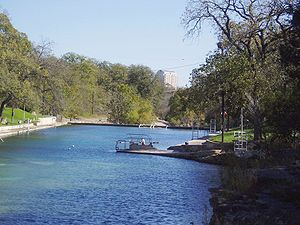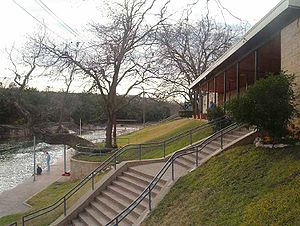
Barton Springs Pool
Encyclopedia

Swimming pool
A swimming pool, swimming bath, wading pool, or simply a pool, is a container filled with water intended for swimming or water-based recreation. There are many standard sizes; the largest is the Olympic-size swimming pool...
located on the grounds of Zilker Park
Zilker Park
Zilker Metropolitan Park is a recreational area in the heart of south Austin that comprises over of publicly owned land. It is named after its benefactor Andrew Jackson Zilker, who donated the land to the city in 1917. It was developed into the park during the Great Depression in the 1930s...
in Austin, Texas
Austin, Texas
Austin is the capital city of the U.S. state of :Texas and the seat of Travis County. Located in Central Texas on the eastern edge of the American Southwest, it is the fourth-largest city in Texas and the 14th most populous city in the United States. It was the third-fastest-growing large city in...
. The pool exists in the channel of Barton Creek
Barton Creek
Barton Creek is a tributary that feeds the Colorado River as it flows through the Texas Hill Country. The creek passes through some of the more scenic areas in Greater Austin and forms a greenbelt that is the habitat for many indigenous species of flora and fauna, including at least seven...
and is filled by water from Main Barton Spring, the fourth largest spring in Texas
Texas
Texas is the second largest U.S. state by both area and population, and the largest state by area in the contiguous United States.The name, based on the Caddo word "Tejas" meaning "friends" or "allies", was applied by the Spanish to the Caddo themselves and to the region of their settlement in...
. The pool is a popular venue for year-round swimming, as its temperature maintains a narrow range from about 68 °F (20 °C) in the winter to about 71.6 °F (22 °C) in the summer.
Admission
The admission fee is $3 for adults, with discounts for season passes, children, and senior citizens. 10 percent of this entry goes to a fund to help protect and research the Barton Springs SalamanderBarton Springs Salamander
The Barton Springs salamander is an endangered lungless salamander that only lives in the habitat of Barton Springs in Austin, Texas, USA...
.
History
Long before Barton Springs Pool was built, the springs were considered sacred and were used for purification rituals by the TonkawaTonkawa
The Tickanwa•tic Tribe , better known as the Tonkawa , are a Native American people indigenous to present-day Oklahoma and Texas. They once spoke the now-extinct Tonkawa language believed to have been a language isolate not related to any other indigenous tongues...
Native American
Native Americans in the United States
Native Americans in the United States are the indigenous peoples in North America within the boundaries of the present-day continental United States, parts of Alaska, and the island state of Hawaii. They are composed of numerous, distinct tribes, states, and ethnic groups, many of which survive as...
tribe who inhabited the area. Spanish explorers first discovered the springs in the 17th century, and around 1730 erected temporary missions at the site (later moving to San Antonio
San Antonio, Texas
San Antonio is the seventh-largest city in the United States of America and the second-largest city within the state of Texas, with a population of 1.33 million. Located in the American Southwest and the south–central part of Texas, the city serves as the seat of Bexar County. In 2011,...
).
In 1837, soon after incorporation of the city of Austin, William ("Uncle Billy") Barton, the springs' namesake, settled the area. Barton named the three separate springs after his three daughters: Parthenia, Eliza, and Zenobia. He, and subsequent owners of the property, recognized its value as a tourist attraction, and promoted it vigorously, thus leading to the swimming hole's lasting popularity.
The last private owner of the property, Andrew Jackson Zilker
Andrew Jackson Zilker
Andrew Jackson Zilker was a political figure and philanthropist in Austin, Texas, after whom Zilker Park was named. He was the last private owner of Barton Springs....
, deeded it to Austin in 1918. During the 1920s, the city undertook a construction project to create a larger swimming area by damming the springs and building sidewalks. The bathhouse was constructed in the 1940s and modeled after the design of the bathhouse at Deep Eddy Pool
Deep Eddy Pool
Deep Eddy Pool is a historic, man-made swimming pool in Austin, Texas. Deep Eddy is the oldest swimming pool in Texas and features a bathhouse built during the Depression era by the Works Progress Administration...
.

Operation of the pool

Dam
A dam is a barrier that impounds water or underground streams. Dams generally serve the primary purpose of retaining water, while other structures such as floodgates or levees are used to manage or prevent water flow into specific land regions. Hydropower and pumped-storage hydroelectricity are...
are closed, and Main Barton Spring
Barton Springs
Barton Springs is a set of four natural water springs located on the grounds of Zilker Park in Austin, Texas resulting from water flowing through the Edwards Aquifer. The largest spring, Main Barton Spring supplies water to Barton Springs Pool, a popular recreational destination in Austin...
fills the pool to a maximum depth of more than 18 feet. At the upper end of the pool, another dam prevents surface water from Barton Creek
Barton Creek
Barton Creek is a tributary that feeds the Colorado River as it flows through the Texas Hill Country. The creek passes through some of the more scenic areas in Greater Austin and forms a greenbelt that is the habitat for many indigenous species of flora and fauna, including at least seven...
from entering the pool by diverting it through a tunnel under the sidewalks.
Although admission to the pool is free from November through mid March, from mid March to October a small fee ($1 to $3) is charged for entry or continued access after 9:00am. Summer passes, valid from Memorial Day to Labor Day, are also available. Lifeguards are usually present except before 8:00am, when swimmers are cautioned to "swim at your own risk". The pool is surrounded by grassy slopes which are ideal for sunbathing. Topless sunbathing is permitted, as in the rest of Austin.
On Thursdays, the pool is closed for cleaning from 9:00am until 7:00pm. The floodgates are sometimes partially opened, lowering the water level in the pool by several feet. Employees then blast pressured water against the limestone bottom of the pool to wash away the hazardous and slippery algae
Algae
Algae are a large and diverse group of simple, typically autotrophic organisms, ranging from unicellular to multicellular forms, such as the giant kelps that grow to 65 meters in length. They are photosynthetic like plants, and "simple" because their tissues are not organized into the many...
buildup. Once a year the pool is closed for several weeks for more extensive cleaning. During this time the floodgates are usually fully opened. With all of the water drained from the pool, the original limestone bedrock of the creekbed reappears.
During large rainfall events, the pool is closed as Barton Creek
Barton Creek
Barton Creek is a tributary that feeds the Colorado River as it flows through the Texas Hill Country. The creek passes through some of the more scenic areas in Greater Austin and forms a greenbelt that is the habitat for many indigenous species of flora and fauna, including at least seven...
may flood and overflow the diversion dam. Swimming in Barton Springs Pool is unsafe during these flood events, as the pool becomes a raging creek.
Environmental issues
The pool has been closed to the public a number of times since the 1980s due to unsafe levels of fecal coliform (E. coli) bacteria in its waters. The source of contamination is still undetermined: many point to upstream urban development as the cause, although others note that high bacteria levels were seen in the 1950s, when development was less pervasive. Contamination is usually worse after heavy rains due to the flushing of the effluent of upstream subdivisions into the Edwards AquiferEdwards Aquifer
The Edwards Aquifer is one of the most prolific artesian aquifers in the world. Located on the eastern edge of Edwards Plateau in the U.S. state of Texas, it discharges about of water a year and directly serves about two million people...
recharge zone which feeds the springs.
The environmental conditions of the springs gave birth to a local political movement called the Save Our Springs Alliance
Save Our Springs Alliance
Save Our Springs Alliance , originally called the Save Our Springs Legal Defense Fund, was a nonprofit corporation created to protect the citizen-drafted SOS Ordinance of 1992 to conserve Barton Springs in Austin, Texas...
(SOS). SOS became a force in Austin municipal politics, leading to many "green" initiatives involving environmental issue
Environmental issue
Environmental issues are negative aspects of human activity on the biophysical environment. Environmentalism, a social and environmental movement that started in the 1960s, addresses environmental issues through advocacy, education and activism.-Types:...
s in addition to those of the springs.
Another environmental issue involving the springs and the pool emerged with the discovery of the Barton Springs salamander
Barton Springs Salamander
The Barton Springs salamander is an endangered lungless salamander that only lives in the habitat of Barton Springs in Austin, Texas, USA...
, a federally listed endangered or threatened species which only exists in the pool and a few surrounding environs. After some debate, and studies by the city of Austin, Texas state agencies, and the U.S. Fish and Wildlife Service, it was determined that swimmers and salamanders could co-exist (as they had probably been doing for some time).
See also
- Barton SpringsBarton SpringsBarton Springs is a set of four natural water springs located on the grounds of Zilker Park in Austin, Texas resulting from water flowing through the Edwards Aquifer. The largest spring, Main Barton Spring supplies water to Barton Springs Pool, a popular recreational destination in Austin...
- Zilker ParkZilker ParkZilker Metropolitan Park is a recreational area in the heart of south Austin that comprises over of publicly owned land. It is named after its benefactor Andrew Jackson Zilker, who donated the land to the city in 1917. It was developed into the park during the Great Depression in the 1930s...
- Edwards AquiferEdwards AquiferThe Edwards Aquifer is one of the most prolific artesian aquifers in the world. Located on the eastern edge of Edwards Plateau in the U.S. state of Texas, it discharges about of water a year and directly serves about two million people...
- Barton CreekBarton CreekBarton Creek is a tributary that feeds the Colorado River as it flows through the Texas Hill Country. The creek passes through some of the more scenic areas in Greater Austin and forms a greenbelt that is the habitat for many indigenous species of flora and fauna, including at least seven...
- Barton Springs SalamanderBarton Springs SalamanderThe Barton Springs salamander is an endangered lungless salamander that only lives in the habitat of Barton Springs in Austin, Texas, USA...
External links
- City of Austin - Parks and Recreation Department: Barton Springs
- Will van Overbeek's Barton Springs photos
- Friends of Barton Springs Pool
- Save Our Springs Alliance
- Barton Springs/Edwards Aquifer Conservation District
- The Edwards Aquifer Website
- Temperature Map of Barton Springs Pool

